Why travellers like me are ditching the beach for long-haul adventure – and going solo

There is a saying in the arid Indian state of Rajasthan that since nature provides so little colour, the people must create their own. And how they do. Truck fronts draped in golden tinsel; saris of vermilion and turquoise; arms ringed in bling; fences of multi-coloured silks keeping antelopes out of the wheat fields; turbans of screaming pink.
By contrast we are a drab lot – eight travellers in pragmatic beige, a bland blur of Rohan. I like to think we are less conventional than we look: we have, after all, chosen India as our destination.
Not for us an Algarve beach, nor the sports bars of Tenerife. We are solo travellers: random Brits aged 57 and upwards, seven women and one man, on a tour specifically for people travelling alone. Two of our group have partners but prefer holidays without them (they don’t like doing the same things, they tell me): the other six of us are widowed, divorced or single. I am single, intrepid and a lover of remote, long-haul exotic destinations. I don’t usually travel with close friends because, variously, they want to sleep on a sun lounger for a fortnight, won’t catch a flight longer than two hours or don’t want to travel where vaccinations are required.
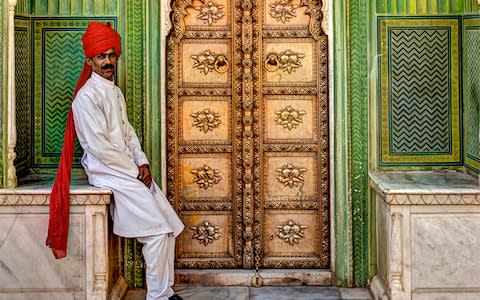
As I grow older and less compromising, I’ve found it suits me to do small group holidays like this one: there’s company if I want it (at dinner, I always do), but also the opportunity to be separate without offending anyone. There’s a strong chance you’ll meet like-minded people, and for me the mix of the social and the solitary works well.
As for India, I’d been on beach holidays to Goa and Kerala many years ago, and wanted to experience this vast country beyond the coastal resorts. An 800-mile midwinter trip through Uttar Pradesh and Rajasthan with other solo travellers and no single room supplement sounded perfect.
Big, noisy cities are not my thing, but nonetheless Delhi was fascinating. It took hours for our small air-conditioned bus to cross it, affording plenty of time to people-watch. All of life was there: grooms arriving for weddings on horses with hooves painted shocking pink; entire families on one moped without a crash helmet in sight; tuk-tuks threading manically between stationary trucks on gridlocked roads.
There was beauty here, too: in the precision marching of a Gurkha regiment at the Changing of the Guard ceremony in front of the President’s Palace, and in the smiling families enjoying the evening sunshine at the sandstone and marble Jama Masjid mosque.
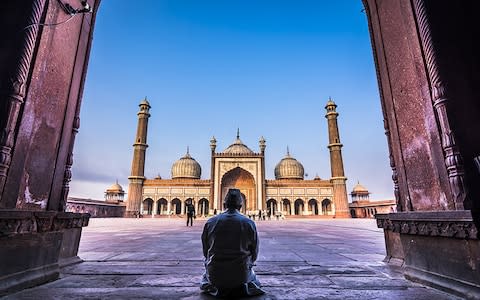
Three times I was asked by random people to be in photographs with them so we stood awkwardly, side-by-side, as the shutter clicked. There were selfie sticks everywhere, young Indian men posing with stiffly pomaded hair, often in clashing checked shirts and trousers and mirrored sunglasses.
Our dinner that first night was the tasting menu at the Haveli Dharampura in Old Delhi, a renovated 19th century mansion house, where we sat on a central terrace under an open sky, eating chaats, soups, paneers, dals, assorted curries and biryanis, while drinking gin and tonics at almost £10 a time.
The group seemed stiff at this first meal: jet-lagged strangers making clumsy small talk.

Our first bonding experience came the following day, after a four-hour drive south delivered us to one of the tour highlights. Now a tourist cliché, the Taj Mahal is probably the world’s most famous monument to love, a vast marble mausoleum built by Mughal emperor Shah Jahan to house the tomb of Mumtaz Mahal, his favourite wife.
We all admitted to feeling a goose bump or two when we laid eyes on it for the first time, and the experience seemed to bring us closer: I’d already decided I liked two of the women on the tour in particular and that we might well become friends.
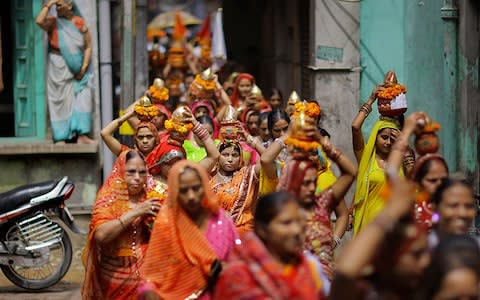
I toured the Taj with Julie and Anne from the group. The three of us traded snippets and stories about ourselves as we walked barefoot round the Taj, seeing it change colour from pink to yellow to cream. We posed on the same bench in front of the Taj where Diana, Princess of Wales, sat in sad-eyed lament for her lonely marriage in 1992. By contrast we laughed, amused by the tiny, bossy Indian man who insisted on grabbing our cameras and taking our pictures, remarking that we are happy to be independent single women rather than cheated wives.
We paused on a terrace to watch women washing clothes in the murky waters of the Yamuna River below, and giggled as we wondered why toffees were on the long list of banned goods in the complex.
On many group trips, I’ve been the only singleton in a sea of marrieds – some of them great company, many not. By contrast, this tour of independent-minded travellers worked well: nobody was clingy or cliquey and, as one of the group remarked, people on their own are often more inclusive and outward-looking than couples.
We quickly fell into an amiable rhythm, dipping in and out of each other’s company as we felt like it.
Why travel on a tour at all? Someone else has done the tedious, time-draining work of putting together a far more interesting itinerary than I could, given their insider knowledge. I also feel safe on a tour, especially if I’m somewhere remote, and there’s always an informed guide to answer my unending questions.

If friends are on a different budget or would rather be in Umbria than India, a tour provides often like-minded company for sightseeing and dinner, with the sanction to spend time alone.
On Day Four, we rose in darkness from our five-star hotel beds and climbed, bleary-eyed, into a jeep which tore along dirt tracks into Ranthambore National Park, once a hunting ground for the maharajas of Jaipur, today a wildlife sanctuary renowned as one of the best places in India to see tigers in their natural habitat.
As the sun rose, our guide spotted a mature tigress down in the dry river bed, and for 30 minutes she walked within 200 yards of our truck, pausing to sniff the wind and twice crossing the track in front of us. We’d been told to keep silent, but our excitement got the better of us and one of our party, Carole, squealed like a schoolgirl.
So far so very lucky, since a sighting is not guaranteed. Then, on our afternoon safari, we saw the same tiger again, then another, bigger female. We watched in awe as she prowled the forest, ever-watchful, our guide offering the proud boast that the Ranthambore reserve had around 15 tigers in it when it was brought under national protection in 1973, and now has around 60.
As holiday experiences go, seeing tigers in the wild is, for me, as good as it gets. My fellow travellers felt the same way as we chatted in the bar that evening over way too many Tanquerays and tonics, high on the shared good fortunes of our day.

A scenic ride on Deogarh’s metre-gauge train took us into mountains for the first time on our trip: northern India’s ubiquitous macaque monkeys, many clutching days-old babies to their bellies, lined up beside the tracks in search of discarded food. One was chewing orange peel, another the remains of a Mars Bar.
“Be careful when the train stops that the monkeys don’t climb on board,” an elderly local man with spectacular black ear hair warned us. Thankfully, that didn’t happen.
As we drove through sprawling ochre plains dotted with emerald wheat and golden mustard fields, to the majestic forts, temples and grand palaces of Jaipur, Pushkar and Udaipur in the land of the maharajas, I felt grateful for the company of my fellow travellers.
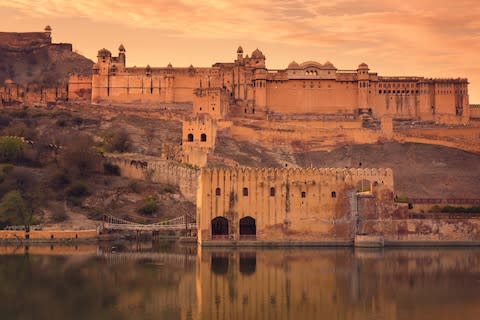
Louise and I skipped dinner one night – seven days in, we joked that we’d reached “peak curry” – choosing instead to sit on a terrace and share, spontaneously, some of the stories of our lives. Love, loss, family, ageing and travel – all were on our agenda. I realised how much I liked her – a bright, savvy, quiet woman who had braved a lot – and I have no doubt we will remain friends.
The same went for Carole, the tiny, funny, scatty group member who made us laugh with her bright-eyed optimism and kind view of the world. She and I often swapped dog stories and photographs, both of us missing terribly the mutts we’d left back home.
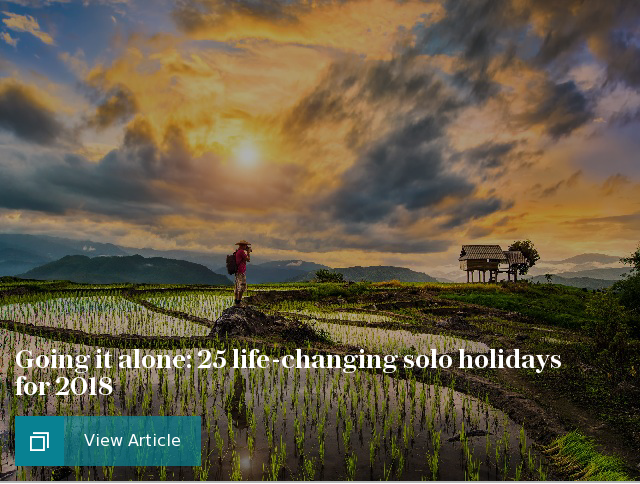
Even the most solitary of people (and I am probably one) sometimes enjoy the company of others, never more than on a shared adventure where so much of what you experience is new and exciting.
Louise and I watched a flock of lime-green parakeets flying overhead in the sunset; Carole and I sipped chai together in a crowded marketplace; and our entire group bobbed about in an open-top jeep, made happy by the warm smiles of children heading home from school who ran behind us, giggling then shouting “Hello! What is the time? I love you!”
Essentials
A 13-day Exotic India tour for solo travellers with Cox & Kings (0203 642 0861; coxandkings.co.uk;) costs from £3,195 pp. Includes flights, accommodation, transfers, excursions, breakfasts and welcome and farewell dinners.


